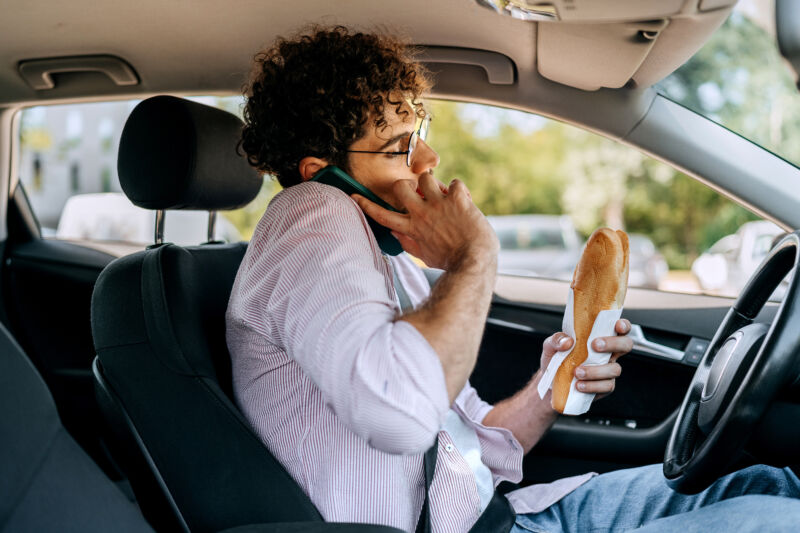just steer yourself —
As drivers become familiar with the systems, they exploit them.

Enlarge / Lane keeping systems let you take your hands off the wheel while you drive.
Getty Images
The seductive lure of cars that drive themselves has led to an awful lot of hype over the past decade. Not everyone enjoys driving, after all, and the idea of freeing up the occupant to read their emails or watch a movie as their car grinds its way to their job led to billions in investments and a whole heck of a lot of GPU sales. We're still a long way from being able to buy a car with fully autonomous driving, but every OEM wants to sell you some level of partial automation that accelerates, brakes, and steers for you. There's just one problem—study after study shows these systems make us less safe on the road.
The latest data points come from a pair of studies just published by the Insurance Institute for Highway Safety, one studying drivers using Tesla's Autopilot, the other focusing on Volvo's Pilot Assist. Both found that when drivers use partially automated driving systems, they pay less attention to the road and start multitasking instead.
The studies were conducted by IIHS together with the Center for Transportation and Logistics at MIT's AgeLab. The studies used Volvo S90 sedans and 2020 Tesla Model 3s, equipped with an array of cameras and sensors to monitor and record driver behavior.
In the Volvo study, of the 29 participants, none had ever driven an S90 before, and 22 had no familiarity using partially automated driving assists. All either commuted five days a week for at least 30 minutes on a highway (each way), or drove at least 100 miles (160 km) on a highway per week, commuting three to four times. The participants were split into three groups, with the third group given slightly different training on how to use the systems, then sent off to use the car as if it were their own for four weeks.
Although there were some differences in behavior between the three groups, the study found that participants were much more likely to engage in distracting behavior such as using a smartphone, eating, or grooming while driving with a partial automation system active. And in two of the groups, their complacency grew with familiarity with the system.
The Tesla study involved 14 participants, none of whom had any experience with partially automated driving. It looked at how drivers triggered and reacted to warnings from the car to pay attention, up to and including being locked out of the system for failing to respond. In total the participants drove 12,161 miles (19,571 km) with Autopilot active, resulting in 3,858 attention-related alerts, 98 percent of which were the lowest-level "apply slight turning force to steering wheel" reminder.
The frequency of these lowest-level alerts increased over the four weeks, but the number of escalated alerts—which occur when a driver ignores the initial prompt—dropped by almost twice as much over the same time period. And yet, like the Volvo study, here the researchers found that drivers were increasingly multitasking with non-driving activities.
What needs fixing?
Both the Volvo and Tesla studies were complicated by software updates during the study periods: two that affected Volvo Pilot Assist and 12 different versions of Tesla software during that study's duration.
"We saw some differences in how the three groups used Pilot Assist, but we couldn’t say for sure they were related to the software changes," said Ian Reagan, IIHS senior research scientist and lead author of the Volvo study. "The takeaway for me was that the technology was linked to more distraction for all three."
Meanwhile, Tesla's escalating alerts worked well. "These results show that escalating, multimodal attention reminders are very effective in getting drivers to change their behavior," said Alexandra Mueller, IIHS senior research scientist and lead author of the Tesla study.
"However, better safeguards are needed to ensure that the behavior change actually translates to more attentive driving," Mueller said.
Indeed, in just over half of the initial alerts in the Tesla Model 3s, the drivers had at least one hand on the wheel. While more modern vehicles are using gaze-tracking driver monitoring systems to ensure the driver has their eyes on the road ahead (and some adding capacitive steering wheel sensors), the Teslas used in the study relied solely on a torque sensor on the steering column to detect driver input.
The need for better safeguards against misuse was echoed by IIHS President David Harkey. "These results are a good reminder of the way people learn. If you train them to think that paying attention means nudging the steering wheel every few seconds, then that’s exactly what they’ll do," Harkey said. "In both these studies, drivers adapted their behavior to engage in distracting activities."